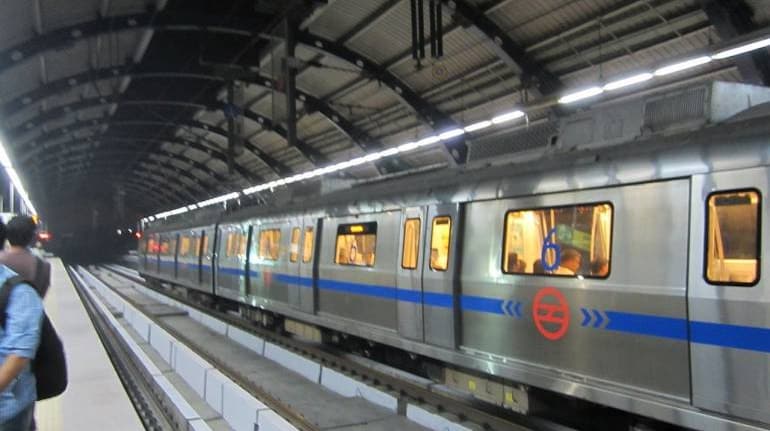Commuters can avail of services on these two lines from 7:00 am to 11:00 am and 4:00 pm to 8:00 pm besides the Yellow Line that commenced operations on September 7.
Two days after the Yellow Line resumed operations, Delhi Metro’s Blue Line and Pink Line are expected to hit the tracks on September 9 as part of the first stage of graded resumption of metro services.
Blue Line from Dwarka Sec -21 to Electronic City/Vaishali (65.35 km and 58 stations) and Pink Line from Majlis Park to Shiv Vihar (57.58 km and 38 stations) will resume operations from September 9 after 171 days, the Delhi Metro Rail Corporation (DMRC) said in a statement.
Commuters can avail of services on these two lines from 7:00 am to 11:00 am in the morning and from 4:00 pm to 8:00 pm in the evening along with Yellow/Rapid Lines which are already operational since September 7.
The reopening of these two lines will ensure that nine of the existing 28 interchange Metro stations would be operational from tomorrow.
These include Rajouri Garden (Blue Line and Pink Line), INA Delhi Haat (Yellow and Pink Line), Mayur Vihar Phase – I (Blue Line and Pink Line), Karkarduma (Blue Line and Pink Line), Rajiv Chowk (Blue Line and Yellow Line), Yamuna Bank (Blue Line 3 and 4), Anand Vihar ISBT (Blue Line and Pink Line), Azadpur (Pink Line and Yellow Line) and Sikanderpur (Yellow Line and Rapid Metro).
The list of Gates which will remain open for entry of passengers at each station along with all necessary updates is available on the home page of Delhi Metro’s official website www.delhimetrorail.com for easy access to passengers.
In addition to the above lines, three more lines- Red Line from Rithala to Shaheed Sthal New Bus Adda (Ghaziabad), Green Line from Kirti Nagar/Inderlok to Brigadier Hosihar Singh (Bahadurgarh) and Violet Line from Kashmere Gate to Raja Nahar Singh (Ballabhgarh) will also resume services from September 10 with the same schedule of four hours of passenger service each in the morning and evening under Stage-I plan of resumption of Metro services.
Thereafter on September 11, the remaining lines will also be reopened under stage-2. These would include the Magenta Line from Janakpuri West to Botanical Garden and Grey Line from Dwarka to Najafgarh.
Under stage 3, the Airport Express Line from New Delhi to Dwarka Sec-21 is expected to be reopened on September 12.
The entire Metro network will be made operational for passenger services throughout the day from September 12, 2020, onwards with all social distancing norms/guidelines to be followed by the passengers during the travel due to ongoing pandemic.
On the second day of restarting operations, the Yellow Line had clocked as many as 8,300 passengers until 11 am on September 8, DMRC sources said.
More than 15,o00 passengers travelled by Delhi Metro on September 7 after it resumed services after almost 169 days due to COVID-19.
Also, as many as 1115 smart cards were sold on the first day.
Very few people decided to avail Metro services as they weighed concerns over health and urgency to reach work.
Platforms and key hub stations, including Rajiv Chowk, were mostly empty and the ambiance far removed from the usual hustle and bustle.
Station employees frequently sanitised areas of the metro station and ensured social distancing, even as several commuters said the closure of most entry-exit gates caused delay and inconvenience.
Trains operated in four-hour batches from 7-11 am in the morning and 4-8 pm in the evening. The services resumed with strict safety and social distancing measures in place.
DMRC said approximately 15,500 people availed the Metro service till 8.30 PM on Monday. On regular days, the average daily ridership of the Delhi Metro is over 26 lakh. No stations on the Yellow Line were closed as none is in proximity to any containment zone, the official said.
The Home Ministry had issued guidelines allowing metro services in the country to resume operations in a graded manner, following which DMRC had said it would be done in three stages from September 7-12.
The DMRC had appealed to passengers to travel light and "talk less inside trains to prevent the possibility of short-range aerosol transmission".
Due to the pandemic and strict social distancing norms, the carrying capacity of a train has been drastically reduced to around 20 percent of the pre-lockdown period.
Passengers had been advised to avoid unnecessary travel as far as possible.
They have also been asked to try and stagger travel timings for office/home/other works to the extent possible so that the carrying capacity offered with new norms can be reasonably utilised by creating a travel pattern in which people are not rushing to the station in morning or peak hours. The idea is to Break the Peak.
To prevent overcrowding in trains/stations, a situation may arise wherein the authorities may have to opt for starting certain empty trains from terminal stations or short loop some trains to manage the crowded zones, the DMRC had said.
It also asked commuters to remember that dwell time will also increase by 10-20 seconds at stations for boarding-deboarding to ensure social distancing. This may also increase the total travel time by a few minutes.
Officials had earlier cautioned that "trains may not stop at some of the stations" if social-distancing norms were not adhered to by passengers.
Besides Delhi, Metro networks also restarted operations on September 7 in a graded manner in Delhi-NCR, Lucknow, Kochi, Chennai, Hyderabad, Bengaluru and Ahmedabad, but remained closed in Mumbai, Nagpur, Kolkata and Jaipur.
Kolkata Metro, the country's first rapid transit system, is yet to resume service.
The Maharashtra government had on September 1 decided against the immediate resumption of metro and local train services.
No decision has been taken on restarting metro services in Jaipur.









